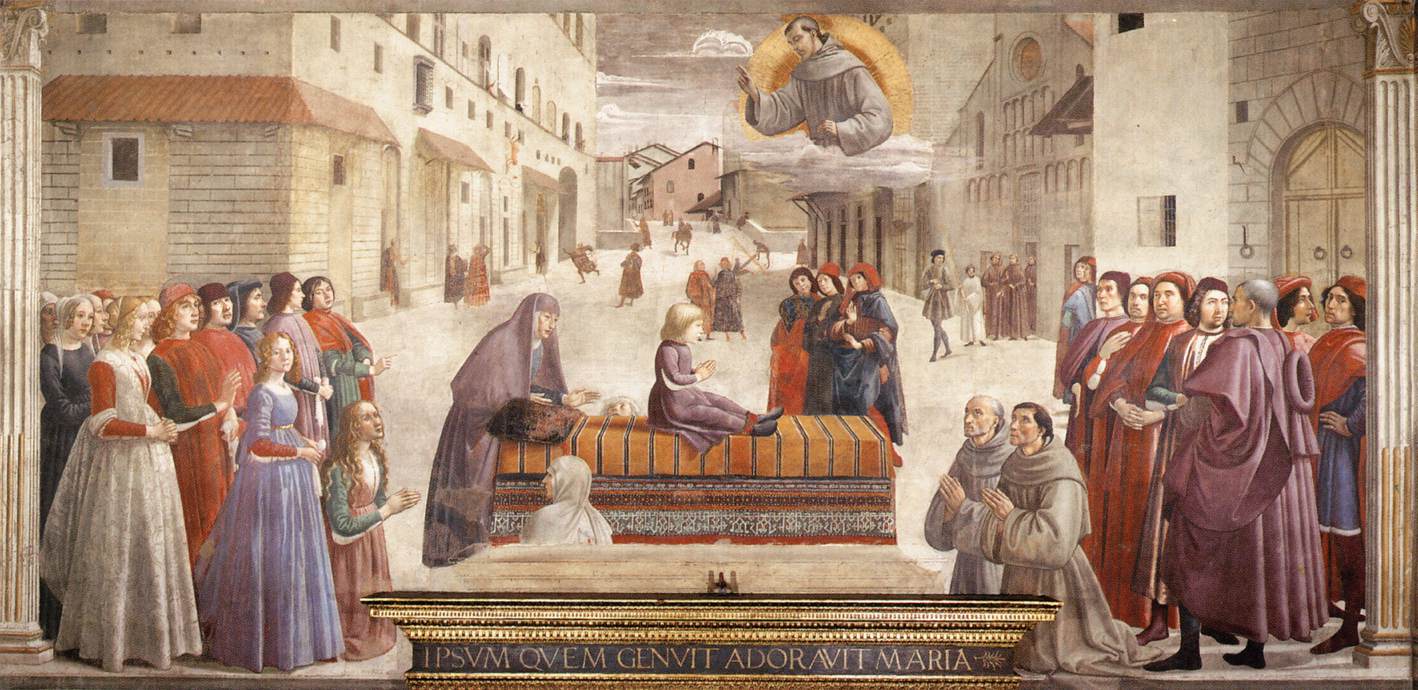1400 – 1600

How to identify Renaissance art?
Click on any of the characteristics of Renaissance art below to see examples.

San Marco Altarpiece by Fra Angelico
This painting is considered a masterpiece for its three-dimensionality and also for being a great example of tompe l'oeil (explained below, feature #4).

Herod's Banquet by Domenico Ghirlandaio

Madonna and Child with Saints by Alvise Vivarini

Perspective View with Portico by Canaletto

Saint Luke drawing the Virgin by Rogier van der Weyden

San Zaccaria Altarpiece by Giovanni Bellini

The Alms of St Anthony by Lorenzo Lotto

The Last Supper by Andrea del Castagno
Note the classical pillars (more on this below in feature #12) and the unusual addition of griffin statues (sphinx-like mythological creatures found in ancient Greece and Egypt)

Execution of Savonarola on the Piazza della Signoria by Francesco Rosselli

The Last Supper Leonardo da Vinci

The Marriage of the Virgin by Raphael

The Creation of the Sun and the Moon by Michelangelo

Lamentation of Christ by Andrea Mantegna

The Annunciation by Jan van Eyck
As hard as it is to believe, this is a painting, not sculpture.

Camera degli Sposi Ceiling Oculus (circular opening) by Andrea Mantegna

Main hall of Palazzo Lancellotti by Agostino Tassi

Sala delle Prospettive of Villa Farnesina by Baldassare Peruzzi

The Sermon of St. Stephen at Jerusalem by Carpaccio

The Virgin and Child with St. Anne by Leonardo da Vinci

The Annunciation by Fra Angelico
Note the Annunciation scene is taking place in a Italian-style loggia (explained below, feature #12).

Torture of St John the Evangelist by Filippino Lippi

The crucifixion aka the Calvary by Andrea Mantegna

St. Sebastian by Andrea Mantegna

Expulsion of Adam and Eve from Eden by Masaccio

The Descent from the Cross by Rogier van der Weyden

The Damned Cast into Hell by Luca Signorelli

San Giobbe Altarpiece by Giovanni Bellini

The Creation of Adam by Michelangelo

Resurrection of the Boy by Domenico Ghirlandaio

Stigmata of St. Francis by Domenico Ghirlandaio

Legend of Saint Ursula - Arrival of the English Ambassadors by Vittore Carpaccio

Disputation with Simon Magus and Crucifixion of St Peter by Filippo Lippi

The Inspiration of the Poet by Nicolas Poussin

The Triumph of Galatea by Raphael

The Feast of the Gods by Giovanni Bellini and Titian

The Birth of Venus by Sandro Botticelli

Primavera by Sandro Botticelli

An Allegory with Venus and Cupid by Agnolo Bronzino
This is a Mannerist masterpeice. Typical features of Mannerism are twisted figures and crowded canvases (more information below, Mannerist features #1 and #3).

Venetia between Justitia and Pax by Paolo Veronese

Wedding Banquet of Cupid and Psyche by Raphael

Wedding Night of Alexander the Great by Il Sodoma

Minerva Sending Away Mars from Peace and Prosperity by Tintoretto

The Rape of Europa by Paolo Veronese

Bia de' Medici by Agnolo Bronzino

Portrait of Cosimo I de' Medici by Agnolo Bronzino

Mona Lisa, aka La Gioconda, by Leonardo da Vinci

Portrait of Innocent X by Diego Velazquez

Portrait of Girolamo Savonarola by Fra Bartolomeo

Portrait of Giovanna Tornabuoni by Domenico Ghirlandaio

Charles VII (1403-1461), King of France by Jean Fouquet

Portraits of the Duke and Duchess of Urbino (Federico da Montefeltro and Battista Sforza) by Piero della Francesca

Portrait of a Man in a Turban by Jan van Eyck

Portrait of Tommaso Inghirami by Raphael

The Garden of Earthly Delights by Hieronymus Bosch

The Hermit Saints by Hieronymus Bosch

St. Peter of Verona Triptych by Fra Angelico

Triptych of St. John the Baptist and St. John the Evangelist by Hans Memling

Portinari Altarpiece by Hugo van der Goes

Madonna of the Magnificat by Sandro Botticelli

Doni Tondo (The Holy Family) by Michelangelo
This tondo is Mannerist style. Typical features of Mannerism here are contorted poses and exaggerated muscles (more information below, Mannerist feature #1 & #2).

The Virgin of the Rocks by Leonardo da Vinci
Da Vinci painted a bizarre rocky landscape behind the Virgin, Jesus and John the Baptist. A similar landscape is more likey to be found in Europe than the Near East.

Adoration of the Shepherds by Domenico Ghirlandaio
Click here to read an analysis of Ghirlandaio's painting.

The Expulsion of Joachim from the Temple by Domenico Ghirlandaio
Click here to read an analysis of Ghirlandaio's painting.

The Visitation by Domenico Ghirlandaio
Click here to read an analysis of Ghirlandaio's painting.

Madonna in the Meadow by Raphael
Note the Tuscan landscape in the background of Raphael's painting of the Virgin, Jesus and John the Baptist. Anachronistically, Jesus takes the cross from John, a sign of acceptance of his future sacrifice.

Cestello Annunciation by Sandro Botticelli

Madonna and Child with Two Angels by Filippo Lippi

Holy Allegory by Giovanni Bellini
A cryptic and bizarre painting: Christian saints, the Virgin Mary enthroned, a baldachin (canopy over a throne) with a scene from the Marsyas myth, two unknown women, a man in a turban, a shepherd, a centaur and four children playing with silver fruits under a tree.

Cutting the Stone by Hieronymus Bosch

Altarpiece: Martyrdom of St. Denis by Henri Bellechose

Netherlandish Proverbs by Pieter Bruegel the Elder

The Stealing of the Dead Body of St. Mark by Tintoretto
Click here to read an analysis of Tintoretto's painting.

The Confirmation of the Franciscan Rule by Domenico Ghirlandaio
Click here to read an analysis of Ghirlandaio's painting.

The Virgin of Chancellor Rolin by Jan Van Eyck
Click here to read an analysis of Jan Van Eyck's painting.

Brera Madonna by Piero della Francesca
How to distinguish the Mannerist (Late Renaissance) among Renaissance artworks?
Note: Mannerism (1520 to 1600), being a Renaissance style, share the above characterisitics but the following sets it apart:
Having trouble viewing this page? View an alternate version here (long page).
Read History of Renaissance art: Why and how it happened.
2. How the Renaissance got its name and what gave rise to it?
3. Why Renaissance artists were rebels?









































